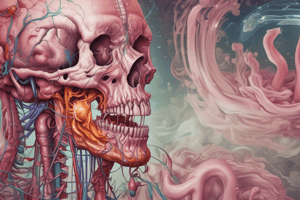Podcast
Questions and Answers
What is the amino acid substitution that occurs in the beta-polypeptide chain of HbS?
What is the amino acid substitution that occurs in the beta-polypeptide chain of HbS?
- Glutamic acid for alanine
- Glutamic acid for valine
- Alanine for glutamic acid
- Valine for glutamic acid (correct)
Why do the manifestations of sickle cell anemia not appear until the later part of the first year of life?
Why do the manifestations of sickle cell anemia not appear until the later part of the first year of life?
- Due to the immature immune system of young infants
- Due to the large amount of HbA present in the RBCs of young infants
- Due to the large amount of HbF present in the RBCs of young infants (correct)
- Due to the small amount of HbS present in the RBCs of young infants
What is the most common type of crisis in sickle cell anemia?
What is the most common type of crisis in sickle cell anemia?
- Vaso-occlusive or symptomatic crisis (correct)
- Sequestration crisis
- Hyperhemolytic crisis
- Aplastic crisis
What is the cause of hand-foot syndrome in sickle cell anemia?
What is the cause of hand-foot syndrome in sickle cell anemia?
What is a complication of sickle cell anemia that can lead to hematuria, papillary necrosis, and renal infarction?
What is a complication of sickle cell anemia that can lead to hematuria, papillary necrosis, and renal infarction?
Study Notes
Splenic Infarction and Complications
- Splenic infarction leads to an initially enlarged spleen, which becomes small and fibrotic with repeated infarctions, resulting in functional hyposplenism and increased susceptibility to infection.
- Ischemic damage can cause retinopathy, delayed puberty, avascular necrosis of the femoral head and humerus.
- Priapism can occur.
Sequestration Crisis
- A large amount of blood becomes acutely pooled in the liver and spleen, causing massive enlargement of these organs and signs of collapse.
- This crisis is a frequent cause of death in young infants.
Aplastic Crisis
- Parvovirus B19 infection can cause red cell aplasia, fever, pain, splenic sequestration, acute chest syndrome, glomerulonephritis, and strokes.
Hyperhemolytic Crisis
- Severe hemolysis, particularly with concomitant G6PD deficiency, can be precipitated by ingestion of an oxidant.
General Manifestations
- Chronic hemolytic anemia
- Liver impairment
- Spleen initially enlarged, then becomes small and fibrotic
- Increased susceptibility to infection (e.g., Salmonella osteomyelitis and H. influenzae meningitis)
Diagnosis
- Moderate to severe normochromic, normocytic anemia with reticulocytosis
- Indirect evidence of hemolysis
- Blood smear: sickle cells, nucleated red cells
- α-globin tetramers form, leading to red cell damage and hemolysis
Clinical Manifestations
- Onset usually in the 2nd half of the first year
- General features of chronic hemolytic anemia
- Failure to thrive in early childhood
- Pallor, jaundice, and gallstones
- Hepatosplenomegaly and hypersplenism
- Abnormal facies: prominence of malar eminence, frontal bossing, depression of bridge of nose, and exposure of upper central teeth
- Manifestation of hemosiderosis
Pathophysiology
- Single amino acid substitution: valine for glutamic acid in the beta-polypeptide chain
- HbS is less soluble than HbA
- Sickle cells are prematurely destroyed, causing hemolytic anemia
- Sickle cells result in increased blood viscosity and impaired blood flow, leading to thrombi
Crisis Types
- Vaso-occlusive or symptomatic crisis
- Sequestration crisis
- Aplastic crisis
- Hyperhemolytic crisis
Studying That Suits You
Use AI to generate personalized quizzes and flashcards to suit your learning preferences.
Description
Learn about the effects of splenic infarction, including enlarged spleen, functional hyposplenism, and increased infection susceptibility, as well as the symptoms of sequestration crisis, such as massive enlargement of the liver and spleen.




